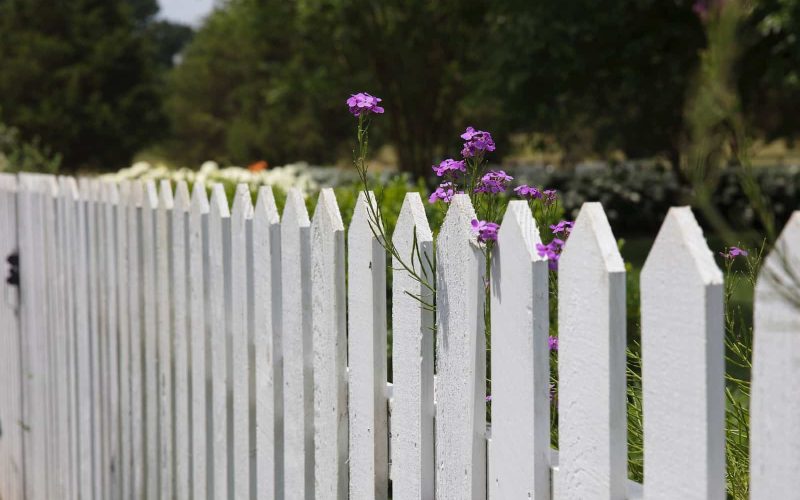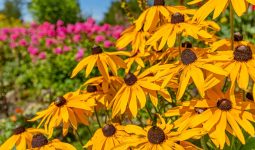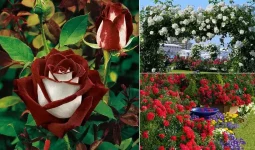Does your fence appear ugly? Are you thinking of what to plant along the fence line? Maybe you don’t like how your neighbors constantly glance at your house.
A fantastic way to improve the appearance of your fence and surroundings is to plant a lovely tree or flower.
Additionally, it will make you feel private. Most people don’t know the right plant to grow, and those who do are unsure how to increase the plant along their fence line.
This post will detail the kinds of plants you should grow for privacy and shade.
Additionally, it will suggest the appropriate plants, shrubs, and flowers for your fence’s border.
Picture yourself strolling a quiet residential street on a warm, beautiful day.
Running your fingers over the fragrant blooms that are peeking through the fence.
Do you envision those sacred plants blooming along your fence line? Are you not sure where to begin? The function they will eventually fulfill will determine what you plant along the fence line.
Maybe all you want to do is make the front of your property more attractive. Or perhaps you want to conceal a bland wall between you and your neighbors’ view.
Maybe you require some privacy from those neighbors and the maximum height of a fence in your town.
Whatever your objective, stay reading to find answers to frequent fence line landscaping conundrums!
What to Take Into Account Before Selecting a Suitable Privacy Plant for Your Fence Line
- The tallness of the privacy hedge
- What kind of trees or grass will best suit your needs?
- Upkeep the grass, bush, or tree
- The privacy hedge’s thickness
What to Plant for Privacy Along a Fence Line
Below are some plants planted along a fence line for privacy:
1. Privet
If you want to increase your level of seclusion, consider privet. It is one of the plants with the quickest growth rates in the US.
The hedging plant can reach a height of 2.8 feet in a year and 11.5 feet when fully grown. This height can be a privacy barrier for fence lines or a fence itself.
Although privet has less attractive, bright-green leaves that will enhance the appearance of your yard, it is an excellent option when considering what to plant along the fence line.
2. Arborvitae
Due to its ability to create privacy screening, this plant is frequently employed; the leaves are what do this. It can grow in the majority of soil types.
There are numerous types of this plant, including enormous and dwarf forms, so you must pick one that will grow along your fence. The plant is elementary and inexpensive to maintain.
3. Bamboo
These plant kinds will give your house seclusion. An ordinary bamboo’s height can assist in keeping noises or intruders from entering your home.
If planted near a pool, their bluish-green color can help give your surroundings a contemporary appearance.
It can occasionally become out of hand and a touch invasive. Not all bamboo species spread uncontrollably, nevertheless.
Fargesia and other bamboo species do not spread quickly or uncontrollably. Because of their clumpy roots, they grow more slowly than other bamboos.
4. Evergreen Trees
Longleaf pine, trees in southern Mongolia, and other species are examples of these trees.
Due to the excellent privacy barrier, these trees provide to the fence lines, they provide coverage throughout the year.
Due to their massive conifers or foliage that reaches the ground, certain evergreens offer greater privacy than others.
Make sure to space your evergreen trees so that their branches contact one another if you want to enjoy the best privacy boundaries they provide.
Every evergreen tree has a particular level of hardiness or the ability to endure in various environments. Find the ideal candidate for your region.
5. Boxwood
Due to their regular use in communal gardens, these hedging shrubs are sometimes known as the aristocrats of other hedging plants.
Horticulturists shape plants into a variety of aesthetically pleasing forms.
Hedging plant species are ideal for the fence line because they have tall hedges and crisps.
Additionally, it gives your house and surroundings seclusion. Boxwood can be a barrier because it grows best in zones 5 through 8.
Some varieties can reach heights of 20 feet. They are also inexpensive and simple to maintain. Create a continuous hedge before planting a boxwood.
This can be accomplished by placing those hedging plants one-half of their mature width apart.
For instance, a boxwood, which can reach 20 feet when fully grown, should be planted at 10 feet in the middle.
This is because, even after being clipped, the plants can still exert much of their privacy-screening capacity. Other hedging plants are affected by this.
Plants to Grow Along a Fence Line for Camouflage
Planting a mixture of shrubs and flowers along your property line will work to hide a chain link fence in your backyard or offer a wonderful backdrop to your garden.
It will also provide food sources and a habitat for birds, bees, and butterflies. We enlisted the assistance of numerous landscape designers to help you maintain this section of your yard.
You can plant your way to a more attractive partition by using the flowers and shrubs that grow best along the fences they share in the above section.
1. Espaliered Fruit Trees
Espaliered fruit isn’t a shrub, but when trees are trained in this shape, they may be kept much smaller, making collecting the fruit easier.
They also look attractive when planted along your fencing. You can lean on the fence for support when training espaliers next to a towable.
The espalier’s lovely form will stand out more against the sturdy background. It is advisable to train these plants against a panel with southern exposure.
The warmth will benefit these trees, causing their fruits to ripen quickly and extending your harvesting season.
2. Climbing Vines
Graham’s top pick, the Eden climbing roses, and this superb fence-lining plant develop swiftly and profusely throughout the summer and early fall.
Climbing up a grey trellis fence, their “creamy tint with a tinge of blush pink in the middle is gorgeous.”
To ensure the success of these climbing vines, constantly remove any broken, sick, or excessively knotted stems.
Then, anchor (and restrict) their growth in the direction of your fences to get a lush appearance.
3. Annabel’s Hydrangeas
Annabel’s hydrangeas bloom into pale chartreuse heads along a fence, appearing ethereal as they sway in the breeze.
It would be best to consider Annabel’s Hydrangeas when considering what to plant along fence line.
These spring through early summer plants will beautifully color your lawn. They also make excellent bird nesting locations.
Water your hydrangeas thoroughly at least once a week (particularly in dry weather), and fertilize them sometimes once or twice a year in the spring or summer.
4. Berry Flowers
Goose, rasp, and blackberries grow into long, fruit-producing canes that thrive when linked to supports, making them excellent fence-lining plants.
Fences can offer that support and make picking the berries easier by allowing you to fan the berries across the fence’s panels.
Flowering Shrubs to Plant Along Fence
When deciding what to plant along the fence line, you are not limited to vining bloomers and creepers.
The following two choices are well known for their color, fragrance, and aesthetic impact as low-maintenance shrubs ideal for the front of your home.
1. Barbara Karst Bougainvillea
The abundant bougainvillea is typical in warm, equatorial areas, climbing over fences and houses’ sides. These have an excellent growth rate of 30% per year and can develop into privacy hedges soon.
The bracts of this striking plant give it its vibrant color, not the tiny, white blooms, one of its distinctive features. They appear from early spring to mid-autumn and are Fuschia, purple, white, and orange.
2. Star Jasmine
The Star Jasmine is a night bloomer since its flowers open around dusk when the temperature drops, releasing the loveliest scent into the air.
In hardiness zones 8 to 11, brilliant white flowers, some of which have yellow centers, bloom profusely from early spring through mid-summer.
This plant’s trailing vines swiftly encircle any fence in a canopy of glossy green leaves, enabling you to plant additional contrasting flowers or evergreens in front of it for further delight.
Landscaping Ideas for Fence Line
Put your aesthetic goals before the functional component of your fence line landscaping. Cottage? Minimalist? Many colors or one color only?
The time has come to select your plants and determine where to place them. Look at these lovely design concepts!
1. Create Cohesive Borders
An essential component of successful fence line landscaping is repetition, and you can utilize the same plant along the fence line to create a unified appearance.
As long as similar aesthetic components are used in other places as well to tie the entire area together. As few as nine plant kinds might provide cohesion inside a fence.
2. Green Borders
Here, “green” might apply to a color scheme or low-maintenance, drought-tolerant plant options.
This practice is called xeriscaping, and let’s look at some motivational instances of both.
The many colors, textures, and heights make this fence line beautiful and exciting.
Select drought-tolerant plants and mulch them with two aesthetically pleasing materials that encourage moisture retention to emulate this.
3. Combination Borders
If the fence line combines sun and shade, you can blend different plant varieties in the same border. Against a sea of green hues, complementary floral colors stand out miraculously.
4. Paint a Dark Fence Backdrop
Why not paint your fence differently to make a magnificent backdrop rather than disguising it with plants? As a result, your landscaping project may only require a small number of plants.
Old or new, a natural wood fence can be incredibly charming. It can be protected by being varnished because it blends well with other natural plantings.
Contrarily, blue fences are causing a stir in the world of design. These will visually blend in as a backdrop for complementary plantings because they reflect the color of the sky on a clear or overcast day.
This is landscape design’s equivalent of the “little black dress.” Simple, elegant, and well-fitting.
Black, a neutral color, gives outdoor spaces a contemporary feel (conjuring up a modern farmhouse) and weathers the elements better than most other colors.
5. Train Fruit Trees
This last choice, planting fence lines, dates back to the Middle Ages. Fruit tree training, sometimes known as espaliers, started in European vineyards.
They increased space and yield by training grape vines to grow along wire fences.
This activity has now become an art form, creating intriguing patterns on garden fences and walls with various fruiting vines and plants. It is also a way to always have access to fresh fruit.
Conclusively, planning carefully and putting time and effort into your fence line is crucial to improving your landscape.
In addition to giving you a sense of solitude for your home and surroundings, planting the correct plant along your fence line will enrich and beautify your landscape.
We sincerely hope you now know better what is feasible in your yard. Use some of these fence landscaping suggestions to make the most of your property while still enjoying your fence.








